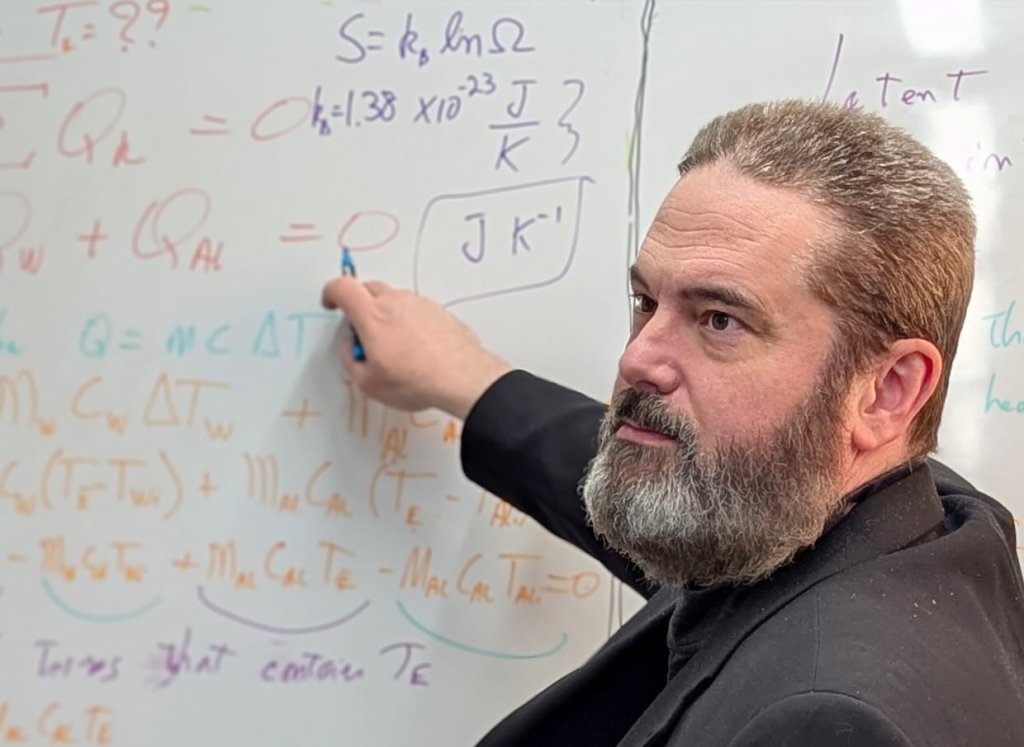
Mathematics at AcadeCap can be broadly divided into three approaches to math instruction. In the International Baccalaureate Primary Years Programme (IB PYP), mathematics is taught using a conceptual, often visual representations and tactile approach. In Grade 7 and 8 or Pre-Secondary School Programme (PSSP), mathematics is taught using a contextual, often story-based approach. Finally, in secondary school, at the OSSD, mathematics is taught in an applied, problem solving approach. In practice, what we describe here as three approaches are really one system that progressively moves from one focus to the others, one continuum approach.
A Continuum Approach to Mathematical Lessons
This continuum approach is fundamentally “concept-before-code.” After all this jargon, it’s fair to ask, “What does this mean?” Well, writing “3 x 4 = 12” is not a multiplication. As surrealist painter René Magritte expressed, the representation of a thing is not the thing itself, see Figure 1.

[Magritte’s “La Trahison des Images” (“The Treachery of Images”) (1928-9)]
Figure 1. Magritte’s “La Trahison des Images” (“The Treachery of Images”) (1928-9) or “Ceci n’est pas une pipe” (“This is not a pipe”), sometimes translated as “The Betrayal of Images” By René Magritte, 1898-1967. The work is now owned by and exhibited at LACMA.
Now, to discuss anything, or in this case, to teach math, one must somehow refer to it. So, how close can we get to the “thing” itself? When teaching multiplication, how close can we get to the underlying concept of multiplication? Although it would be fascinating to continue with this questioning, delving into epistemology and the philosophy of education, a practical answer presents itself.
The Cognitive Science Behind Early Math Education
There is a body of literature in cognitive science that suggests that vision centres develop in the brain before language centres do and that language centres are developed, in part, by hijacking parts of the brain that are dedicated to vision in very young children. [Dehaene, 2007; and others that reference this article] Therefore, if we use visual representations, or even tactile, representations of mathematical concepts to teach primary years children, see Figure 2, these children gain a deep understanding of these concepts. [Fuson, 1990; Uttal, 1997; and multiple articles that reference these]
From Visual Representations to Math Concepts
As they progress through grade school, after the foundational concepts have been integrated, the symbolic code of mathematics can be taught, a bit like putting labels on concepts that have already been understood.

[A visual representation of 3 x 4 = 12.]
Figure 2. A visual representation of 3 x 4 = 12.
AcadaCap’s proprietary curriculum, the 21st Century Learning Curriculum ©, teaches math using this ‘concept-before-code’ approach. This math class approach ensures that students understand mathematical concepts before focusing on the mathematical language.
The Benefits of Concept Before Code for Three Different Types of Learners
For children with learning challenges:
Concept-before-code enables students with dyscalculia to learn math at the same pace as their peers, with a minimum of dedicated dyslexia remediation activities outside of regular class and homework time.
For children with giftedness:
Often, children with learning exceptionalities are driven to learn mathematics by rote because this is the quickest way to accomplish what they see as ‘obvious’. Concept-before-code brings these students with learning exceptionalities to see the underlying concepts of the mathematical concepts and not just the obvious-to-them answer. This avoids the pitfall in later years when some gifted students find it difficult to explain the why and the how of an answer.
‘Pour tous les apprenants’
Concept-before-code fosters a strong, intuitive grasp of mathematical ideas and concepts before introducing symbolic procedures. This approach enables students to connect new ideas to prior knowledge more readily, improving their engagement and confidence. Ultimately, diverse groups of students progress steadily alongside their peers.
Math Achievement and Competitions
One of the ways we measure the effectiveness of our approach to mathematics is via our students’ huge success in the COMC, the CJMC competitions, and other mathematics competitions. For instance, in the Caribou problem-solving contest, across all grades, on average AcadeCap students rank in the top 25% in the world, and our highest-scoring students rank in the top 1%.
The COMC, or Canadian Open Mathematics Challenge, is open to students from grades 9 to 12, CEGEP, and early University, from around the globe. This year’s COMC-2024 competition was written by more than 6300 students, including 672 international students. The CJMC, or Canada Jay Mathematical Competition, is a challenge open to grades K-8. This year’s CJMC-2024 competition was written by more than 3,500 students. Internationally, the median score for the COMC was 33%, and the median score for the CJMC was 45%. These are two tough tests!
Most schools field only their top students for the COMC and CJMC. At AcadeCap, every student deserves the opportunity to challenge themselves. Such challenges prepare students for life after school.
Overall, our senior students improved their scores in the COMC from 2023 (our first year participating) to 2024 by more than 50% (x 1.5).
On the CJMC, our two highest-scoring grade 7 students were, respectively 1 and 2 points shy of obtaining an award certificate.
Our PYP mathematics programme did shine even brighter than last year. In the primary-years Ontario East division, there were 17 CJMC award winners, and seven were from AcadeCap!
The following primary-grade students received awards in the CJMC:
J. S. – Honourable Mention – Eastern Ontario – Grade 4 or under
G. F. – Honourable Mention – Eastern Ontario – Grade 6
E. B. – Bronze Award – Eastern Ontario – Grade 4 or under
M. S. – Silver Award – Eastern Ontario – Grade 4 or under
V. B. – Silver Award – Eastern Ontario – Grade 5
Q. A. – Silver Award – Eastern Ontario – Grade 6
A. S. – Gold Award – Eastern Ontario – Grade 6
For Parents: Partnering on Your Child’s Math Journey
Families in Ottawa who wonder how to teach engaging math lessons at home often ask what comes next. The answer is partnership: at school we build number sense, conceptual understanding, and problem solving through coherent math instruction; at home you connect seemingly abstract mathematical concepts to the problem solving skills will all rely on in daily life—recipes, errands, budgeting, games—so students see the real-world “why” for developing their math skills.
To glimpse how ideas link across subjects, explore our iSTEAM curriculum: a fully integrated program from primary to secondary, supported by a dedicated iSTEAM lab beside our media and art rooms, and enriched by partnerships (Let’s Talk Science, Hour of Code/Computer Science Education Week, Scientists in School, Maker Junior, Carleton University, and the University of Ottawa’s Maker Mobile).
Read why AcadeCap has had such a positive impact on so many lives. Have questions or next steps in mind? Contact our admissions team to start a conversation or book a campus visit.
Frequently Asked Questions About Math Instruction
What is the best way to teach math?
We believe that the most effective way to teach abstract math concepts lies in the “concept-before-code” approach: begin with conceptual understanding using visual and tactile models so learners grasp the foundational knowledge bound up in the idea itself.
Once that foundation is secure, introduce the mathematical reasoning, language, and symbols, then extend learning through application and problem solving. This progression—concept, then language, then application—is the throughline of our program from PYP to Secondary.
What are the methods of teaching math?
At AcadeCap we use a coherent continuum rather than isolated techniques. In the IB PYP, learning is conceptual, often visual and tactile. In the PSSP, learning is contextual and frequently narrative-based. In Secondary, learning is application-based with a strong focus on problem solving. Together these stages function as one system that moves naturally from concept to language to application.
What are the six key principles for effective teaching of mathematics?
Our approach rests on six principles: concept-before-code; the use of visual and tactile representations to ground ideas; context and narrative to make new learning meaningful; application and problem solving to extend understanding; introducing mathematical language and symbols after concepts are secure; and sustaining a continuum across years that supports diverse learners—from those with learning challenges to those with giftedness—so everyone progresses steadily.
References
Dehaene, S., & Cohen, L. (2007). Cultural recycling of cortical maps. Neuron, 56(2), 384–398.
Fuson, K. C., & Briars, D. J. (1990). Using a base-ten blocks learning/teaching approach for first- and second-grade place-value and multidigit addition and subtraction. Journal for Research in Mathematics Education, 21(3), 180–206.
Uttal, D. H., Scudder, K. V., & DeLoache, J. S. (1997). Manipulatives as symbols: A new perspective on the use of concrete objects to teach mathematics.
Non-programmable calculator still required: 7 to 12
Calculator use introduced progressively from Grade 4 onward in Défi Mathématique
